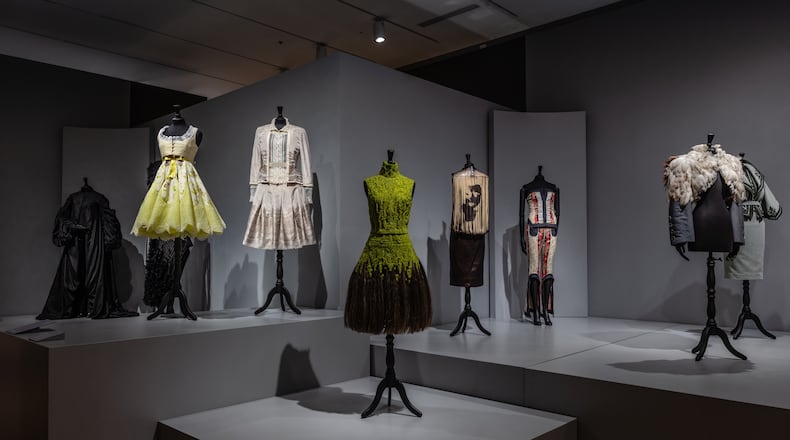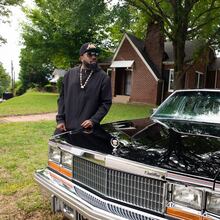The late fashion designer Alexander McQueen is now considered one of the most important designers of the last 50 years. Since his 2010 death, he’s been hoisted into the pantheon of contemporary greats like Karl Lagerfeld in Paris, Gianni Versace in Milan and Halston in New York.
Even among such lofty company he was the only one to successfully marry the fresh ingredients of high style, concept, emotion and technique to reflect the urban, transgressive London of the early 1990′s — a place and time of seedy Soho clubs populated by exciting new creatives like Leigh Bowery, Damien Hirst and Tracey Emin who were full of unbridled, dangerous artistic expression. It’s the unique mix that would propel a young English “lad” to the heights of global design stardom.
And now the results of his prodigious talent are on display in a wonderfully intimate exhibition in the Columbia Museum of Art on Main Street in downtown Columbia, South Carolina. “Lee Alexander McQueen and Ann Ray: Rendez-Vous” is produced by Barrett Barrera Projects based in St. Louis, Missouri, where the exhibit debuted in 2019.
Credit: Ann Ray
Credit: Ann Ray
To fully appreciate the exhibition requires some historical context. The McQueen story has become one of lore. The son of a taxi driver, born in East London, he first apprenticed as a tailor on Savile Row. He would then get a master’s degree at Central Saint Martins (the Harvard of design schools in the world) and in 1993 finally started his own label, which landed like a macabre cannonball into the pool of a somewhat conservative fashion scene at the time.
This exhibit is just as much about McQueen as it is about his friend, French photographer Ann Ray, the only photographer given behind-the-scenes access to McQueen’s atelier and runway shows. Sixty of her photographs are shown alongside 50 of McQueen’s garments.
Ray’s presence in the exhibit gives it a palpable intimacy. On display are special garments from her own closet that the designer gave to her during their tender friendship. There is a beautiful, long black tuxedo jacket with large satin lapels that she wore in Paris with him. A cashmere coat, outlined with thin black, shiny leather strips, was given to her when he couldn’t be by her side. He sent a note with the coat stating, “I wish I could be there to hug you, but at least you have this coat to keep you warm.”
Garments for McQueen were both a vehicle for his artistic expression and a love letter.
For Jackie Adams, museum director of education and engagement who curated the exhibit alongside Barrett Barrera Project’s Susan Barrett and Kelly Peck, the exhibit is her own letter of love. “This exhibition is personally significant to me because I first saw Alexander McQueen when I was around 15,” she says. When he was actively putting out collections and showing them, “I was coming of age, so it just rocked my world.”
The exhibition spills out over six spaces that flow together somewhat chronologically, displaying the designer’s body of work alongside Ray’s images. There is a dress, from his last collection in 2010, made of a silk jacquard woven in the image of a painting by the 16th century Dutch painter Hieronymus Bosch. It is this level of intimacy and proximity to the pieces that make this exhibition so interesting. One can see the seam work, the texture, the silhouette. To see that dress in detail elevates a somewhat simple garment to a higher plane.
Credit: David Johnson
Credit: David Johnson
McQueen’s life was shaped by women. Ray is one, as was his mother, Joyce. Then there was his mentor, Isabella Blow. The eccentric British fashion editor who came from aristocracy championed him and remained his muse. Their relationship was full of passion and pain. “He’s a wild bird with a good silhouette and his whole work is about being a bird,” she once told a TV reporter. “So, birds have movement, they have freedom, they’re wild, they’re free, they don’t have to be responsible to anyone other than to their great technical ability to fly. And I think he makes clothes fly.”
She’s there in one of the latter rooms that features a seamed, “tailleur” (French for a tailored woman’s skirt suit), cut in cream snakeskin. The look comes from one of McQueen’s pivotal collections, the 2008 La Dame Bleue, a show that paid homage to Blow after she died from suicide in 2007.
In February 2010, the man whose mind and hands produced so much beauty, would meet an ugly end. McQueen, then 40, took his own life at his home in Mayfair, London. By that point his small artisanal business had become a large corporate structure, bought up by the French luxury conglomerate Kering, then known as Gucci Group. The designer’s mother, the most important figure in his short life, had died, and he was living with a chronic illness. Sources say the designer was burned-out and worn down. Drugs were involved.
In the still of night, he hung himself with a belt. His cleaners would find him in the morning, and the BBC would report the coroner’s finding that, at that time, “The balance of his mind was disturbed.”
This exhibition in Columbia comes at an interesting time. Earlier this year Sarah Burton, who started as an intern for McQueen and rose to take over the house after his death, left the company after presenting the Spring 2024 show this past September. She was the last tether to the house’s origins. McQueen is gone, and now so is she. The name, the brand, will move onto its next life under completely new, creative leadership.
“I would like people to feel what I felt the first time I saw Lee Alexander McQueen’s work, which is to take your breath away, and I want them to feel a sense of spirit in the show through Ann Ray’s lens,” says Adams. “I think that the two coming together will create an incredibly inspirational moment for people that may go in many different directions, so that’s what I’m hoping for. What I’ve been told by (McQueen friend and collaborator) Simon (Ungless) and Ann Ray is that this is probably one of the most authentic stories and presentations of McQueen and who he was as a person that you will see amongst all of the material that’s available on him now.”
Credit: Victor Johnson
Credit: Victor Johnson
The most moving part of the exhibit comes at the end, where original patterns the designer cut in 1995 are laid out. You can see the scribbles, the changes, the process. It’s amazing. He touched them, used them. It’s a close encounter with a person and a time and a place that has become so culturally significant.
ART EVENT
“Lee Alexander McQueen and Ann Ray: Rendez-Vous.” Through Jan. 21. $15. Columbia Museum of Art, 1515 Main St., Columbia, S.C. 803-799-2810, columbiamuseum.org







